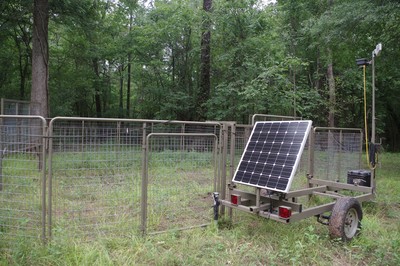Q&A: Fighting the Feral Hog Problem

Darwin Hendrix lives in Antoine in Pike County and owns property in southwest Arkansas. He is a member of the 22-member Feral Hog Eradication Task Force appointed in 2017 to examine ways to control and eradicate the wild hogs which are roaming free and causing millions of dollars in damage to property and cropland. Hendrix has been trapping feral hogs for the past 10 years with some success and he recently discussed the issue with us and what he believes it will take to bring them under control.

Darwin Hendrix
Feral Hog Eradication Task Force
Q: Mr. Hendrix, describe the make-up of the task force. What is it’s purpose?
A: The task force was formed in July, 2017. We have had nine meetings. It’s multi-party with 17 state and non-government organizations. The members are farmers and ranchers, timber owners, representatives of the Game and Fish Commission and , NRCS. Agriculture secretary Wes Ward chairs the task force. The purpose of the task force is to increase public understanding, come up with some sound regulations and enforcement and increase resources to landowners to control the feral hog situation. We think there’s been about $1.5 billion-plus damage in our country from feral hogs and the majority of that of course is to agriculture.
Q: What recommendations or regulations has the task force come up with?
A: That it should be illegal to transport and release live hogs in Arkansas. That’s the number one key that I think we have accomplished. Hogs are being transported and released live. They also carry diseases like pseudorabies and swine flue and that just spreads the epidemic.
Q: I understand you have been successful trapping feral hogs over the past 10 years. What has been your method and how do you successfully trap them?
A: It’s been an educational process. I started by myself trapping 10 year ago and was catching hogs four to five at a time. But I was in contact with a professional trapper, Scott Cagle, who has taught me a lot. I am paying him now as my technician to monitor the traps. We use cell phones and motion cameras to detect how many hogs are in the “Sounder.” That’s the large social group that they run in. We’ve been very successful in not dropping the gate until we have the complete sounder in the trap at one time. If any hogs are left outside the trap they will learn not to go in making it difficult to capture them all. They are very smart animals. The phone alerts you to movement in the trap and sometimes it’s not hogs. It can be other animals but you have to be very patient and your phone can go off 15 times a night with alerts that may not be the full group of hogs. The sows are very smart, they can keep their pigs out of the trap. So it’s a process. Sometimes we’ve had to wait two to three weeks before we drop the gate on a sounder. We’ve caught like 180 on my farm since the end of deer season.
 A feral hog trap in Clay County.
A feral hog trap in Clay County.
Q: Will we ever be able to effectively control these hogs?
A: If we’ve got the proper people running the traps that know what they’re doing, that are patient. I think we can come close to eliminating them.It’s going to be a process, it’s not going to happen in a year. But the technicians that are paid to run the traps are the key. The technician that knows what he’s doing, that can decide where the bait site is, that’s important. You just can’t put the trap up anywhere. But it will be costly and not all landowners want to spend the money necessary.
Q: How costly will it be?
A: There’s going to have to be some serious consideration to sources of funding because a technician is going to need to make a salary and will have to have a vehicle. He will need to have a 4-wheeler or side by side to get into the remote places where the traps need to be located. I can see it costing $80,000 to $100,000 per technician easily.
Q: I’ve read where the chemical or poison Kaput may be an effective control method. Is it being considered?
A: There are studies being done on poison and it’s not been licensed yet anywhere to my knowledge. We must do extensive research to make sure we’re not going to hurt other wildlife or humans. I think eventually it would have to be technicians using that. I don’t think the average farmer or property owner should. It would have to be a licensed applicator to use that poison. If all else fails that may be a solution.
Q: Any final thoughts on why this is such a critical issue and what needs to be done?
A: 25 years ago we had no hogs in this area and I do believe they were brought in and turned loose. That’s devastating because you’re just starting them in a new area. It has been reported feral hogs have been sighted in every county in Arkansas. Studies say that you have to eliminate 70 percent of the hogs to keep the population from increasing. They reproduce quickly. If they have four to five to a litter and begin breeding before they are a year old and have two to three litters a year you can just imagine how much they would increase.
Funding is going to be key. Who pays for technicians? How is funding generated? Taxes? I don’t think a voluntary system is going to work. Maybe an additional millage on property taxes which is probably going to be very unpopular. But something’s going to have to be done.


